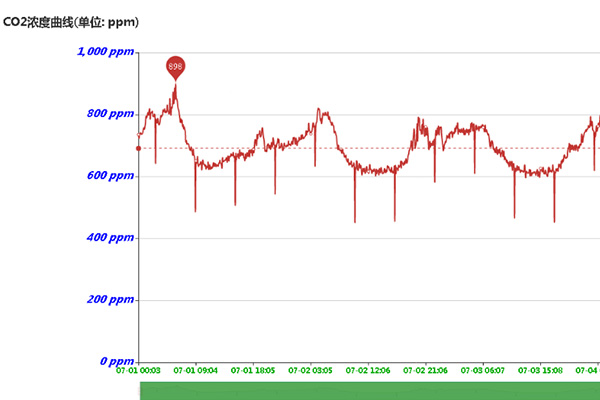

— Blogs —
—Products—
 Consumer hotline +8618073152920
Consumer hotline +8618073152920 WhatsApp:+8615367865107
Address:Room 102, District D, Houhu Industrial Park, Yuelu District, Changsha City, Hunan Province, China
Product knowledge
Time:2024-11-17 20:25:34 Popularity:491
A carbon dioxide sensor is a device used to detect the concentration of carbon dioxide (CO2) in the air. It utilizes a specific operating principle to accurately measure the amount of carbon dioxide in the environment, providing critical environmental data for a variety of application scenarios.

The operating principle of CO2 sensors is based on the following technologies, the most common of which is non-dispersive infrared (NDIR) technology.
- Principle: The NDIR sensor contains an infrared light source, a sample chamber, a filter of a specific wavelength and an infrared detector. When infrared light passes through the sample chamber containing air, CO2 molecules absorb infrared light at a specific wavelength (e.g., 4.26 μm). The detector measures the intensity of the light after passing through and calculates the CO2 concentration due to the increase in light absorption caused by the increase in CO2 concentration.
- Advantages: High accuracy, selectivity and stability, widely used in various environmental monitoring and control scenarios.
- Principle: Electrochemical sensors detect CO2 concentration through a chemical reaction. The sensor contains an electrolyte that reacts with CO2, and the electrical signal generated by the reaction is proportional to the CO2 concentration.
- Advantages: Lower cost, suitable for portable and low-cost applications.
- Principle: Semiconductor sensors detect CO2 by utilizing the property that the resistance of the semiconductor material varies with the concentration of CO2. when the concentration of CO2 varies, the resistance of the semiconductor varies accordingly, and the concentration of CO2 can be determined by measuring the change in resistance.
- Advantages: Fast response time, suitable for rapidly changing environments.
- Principle: Thermal conductivity sensors detect CO2 by measuring the thermal conductivity of the gas. the thermal conductivity of CO2 is different from that of other gases, so the CO2 concentration can be inferred from the change in thermal conductivity.
- Advantages: Simple structure, suitable for some specific applications.

- Indoor air quality control: CO2 sensors help to maintain a suitable breathing environment and prevent excessive CO2 concentration, which can affect human health.
- Air quality assessment: real-time monitoring of carbon dioxide concentration in the environment, to provide data support for air quality assessment to prevent air pollution.
- Production safety: In environments such as factories and mines, CO2 concentration is monitored to ensure worker safety and avoid the risk of asphyxiation.
- Production process monitoring: Monitor gas concentration during production to ensure the safety and stability of the production environment.
- Greenhouse cultivation: Promote crop growth and improve yield and quality by regulating CO2 concentration.
- Precision agriculture management: Monitor CO2 concentration in farmland to optimize irrigation and fertilization programs.
- Indoor air quality: In offices, schools, hospitals and other public places, CO2 sensors can monitor indoor air quality and prevent health problems caused by high CO2 concentration.
- HVAC system: In HVAC systems, ventilation is automatically adjusted according to CO2 concentration to improve energy efficiency and reduce energy consumption.
- Ventilator and anesthesia monitoring: monitoring CO2 levels in patient's breath to ensure safe treatment.
- Vehicle emission monitoring: assess air quality and monitor CO2 concentration in vehicle emissions.
- Climate change research: monitoring changes in CO2 concentration in the atmosphere, providing data support for the study of global climate change.
- Family: monitoring and controlling indoor air quality to ensure health and comfort.
- Office: Ensure a comfortable and efficient environment for occupants.
- Schools: Maintain a good learning environment and improve students' learning efficiency.
- Hospitals: Maintaining a high quality healthcare environment to safeguard the health of patients.
- Greenhouses: Optimize plant growing conditions and increase crop yields.
- Agricultural greenhouses: monitor the carbon dioxide concentration inside the greenhouse to provide a suitable gas environment for crop growth.
- Chemical plants: monitor the gas concentration during the production process to ensure production safety.
- Mines: Ensure the safety of workers and avoid the risk of asphyxiation.
- Underground parking lots: monitor air quality to ensure the safety of vehicles entering and exiting.
- Vehicle emission monitoring: assessing air quality and monitoring the CO2 concentration emitted by vehicles.
- Integration into smart systems: automatic regulation of the indoor environment for improved quality of life and energy efficiency.
- Climate change research: field studies and data collection related to atmospheric CO2 levels.
Installing a CO2 sensor usually involves following the steps outlined below, but please note that specific installation steps may vary depending on the sensor model and manufacturer's instructions. The following are general installation guidelines:
- Representative: Ensure that the installation location is representative of the average CO2 level in the area to be monitored.
- Avoid interference: Avoid installing the sensor where it will be directly exposed to sunlight, wind, rain, or heat.
- Away from sources: Ensure that the sensor is located away from sources that may produce CO2, such as combustion equipment or vents, to avoid erroneous readings.
- Indoor Height: For indoor installations, the sensor should be located at the height of the person's activity area, typically between 1.5 and 2 meters.
- Tools: Make sure you have the right tools, such as screwdrivers, drills, wire cutters, and so on.
- Accessories: Prepare the necessary installation accessories such as screws, brackets, tape or anchor bolts.
- Wall-mounted: Mark the mounting position on the wall, drill holes and install fixing screws or anchor bolts to fix the sensor on the wall, make sure it is stable and level.
- Hanging type: Hang it at a suitable height using a boom or cable.
- Power supply: According to the power requirement of the sensor (e.g. DC 12V-24V), connect the power cable to the sensor and make sure the power supply is stable and reliable.
- Signal line: If the sensor supports remote data transmission (e.g. RS485, 4-20mA output), connect the corresponding signal line.
- Check connections: Make sure that all connections are firm and correct, and that the cables have been properly secured to avoid any possible damage.
- Calibration Tool: Calibrate the sensor using a calibration tool or procedure according to the manufacturer's instructions.
- Calibration ensures: that the sensor provides accurate readings.
- Functionality Test: after installation is complete, test the sensor to make sure it is working properly.
- Signal Check: Check that the correct output signal is present and that the readings are reasonable.
- Organize Cables: After confirming that the sensor is working properly, organize all cables to ensure that they do not pose a tripping hazard to personnel movement.
- Protection: If the sensor requires protection (e.g., a shield), install it properly.
- Record information: Record the date the sensor was installed, its location, and any relevant calibration information for future maintenance and calibration.
Carbon dioxide sensor (CO2 sensor), as an important environmental monitoring device, has a wide range of applications and important social value. Through its accurate monitoring ability, it not only improves people's quality of life, but also shows its important value in environmental protection, productivity improvement and scientific research. With the continuous development of science and technology, the performance of carbon dioxide sensors will continue to improve, bringing more convenience and protection to people's life and work.
NBL-W-CO2-Carbon-Dioxide-Sensor-Instruction-Manual-2000ppm.pdf
NBL-W-CO2 Carbon-Dioxide-Sensor-Instruction-Manual-5000ppm.pdf
Related recommendations
Sensors & Weather Stations Catalog
Agriculture Sensors and Weather Stations Catalog-NiuBoL.pdf
Weather Stations Catalog-NiuBoL.pdf
Related products
 Combined air temperature and relative humidity sensor
Combined air temperature and relative humidity sensor Soil Moisture Temperature sensor for irrigation
Soil Moisture Temperature sensor for irrigation Soil pH sensor RS485 soil Testing instrument soil ph meter for agriculture
Soil pH sensor RS485 soil Testing instrument soil ph meter for agriculture Wind Speed sensor Output Modbus/RS485/Analog/0-5V/4-20mA
Wind Speed sensor Output Modbus/RS485/Analog/0-5V/4-20mA Tipping bucket rain gauge for weather monitoring auto rainfall sensor RS485/Outdoor/stainless steel
Tipping bucket rain gauge for weather monitoring auto rainfall sensor RS485/Outdoor/stainless steel Pyranometer Solar Radiation Sensor 4-20mA/RS485
Pyranometer Solar Radiation Sensor 4-20mA/RS485
Screenshot, WhatsApp to identify the QR code
WhatsApp number:+8615367865107
(Click on WhatsApp to copy and add friends)